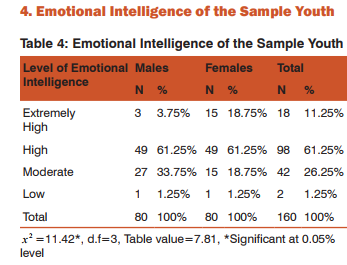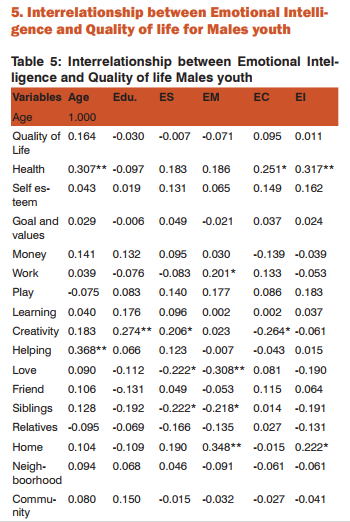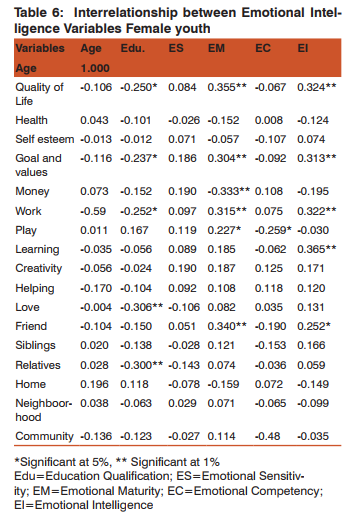IJCRR - 7(2), January, 2015
Pages: 01-05
Print Article
Download XML Download PDF
RELATIONSHIP BETWEEN QUALITY OF LIFE AND EMOTIONAL INTELLIGENCE OF THE SAMPLE YOUTH
Author: Sarika Manhas, Anupa Sharma, Manisha
Category: General Sciences
Abstract:The present research was carried out with the aim of assessing the relationship between Quality of life and Emotional Intelligence among youth of Jammu city. The sample for the study comprised of 160 employed youth of Jammu city, half of who were males and rest females. The sample was selected through multi stage sampling technique where in the actual sample was selected randomly. The tools used for investigation / data collection were a standardized Emotional Intelligence scale developed Chadha and Singh (2003) and Quality of Life scale developed by Frish (1994). Correlation analysis reveals that for both male as well as female youth certain components of quality of life were significantly related with emotional intelligence and its sub components, pointing towards a significant association between emotional intelligence and quality of life.
Keywords: Emotional Intelligence, Quality of Life, Youth, Emotional Maturity
Full Text:
INTRODUCTION
Emotional intelligence refers to the ability to perceive emotions, to assess and generate emotions so as to assist thought, to understand emotions and emotional knowledge, and to reflectively regulate emotions so as to promote emotional and intellectual growth. Emotional Intelligence (EI) is about intelligent use of our emotions. This requires being aware of our feelings and the feelings of others in order to manage our behaviour and relationships effectively. EI is an area of cognitive ability involving traits and social skills that facilitate interpersonal behavior. It is the ability to sense, understand and effectively apply the power and acumen of emotions as the sources of human energy, information, connection and influence (Copper and Sawaf 1997). World Health Organization defines Quality of life as “an individual’s perception of their position in life in the context of the culture and value systems in which they live and in relation to their goals, expectations, standards and concerns. Quality of life is a broad concept that incorporates all aspects of life and has been used in a variety of discipline such as: geography, philosophy, medical sciences, social sciences, health promotion, and advertising (Oort et al 2005). Lindstro (1994) has presented a model where quality of life was divided in a different way into four life spheres /the global, external, interpersonal and personal sphere where the last one was represented by the physical, mental and spiritual dimension. The main thing that determines quality of life is our ability to enjoy all that life has to offer. For instance, the ability to walk, talk, see and feel all contributes to our overall quality of life. A quality of life is a life full of meaning and purpose. A highquality life is also a life of freedom from tyranny. Emotional maturity emerges as an important factor in youth’s socio-emotional development. The current conceptualization of Emotional Intelligence provides an opportunity to see how it has been interpreted and applied throughout the world. Emotional intelligence continues to be effected by many factors. Though there is a world wide research on this topic but only a few researches have been conducted on this topic in Jammu region. Many past researchers have focused on the emotional quotient of managers and professionals already working in the field overlooking the youth who are the future leaders and managers. This study attempts to assess the relationship between emotional intelligence and quality of life of youth. It would be interesting to know the level of EI and quality of life among youth and to relate it to their sex and age. The information gathered through the present study will be helpful in understanding the youth better and also the role of some demographic characteristics in shaping the youth’s emotional intelligence and quality of life will be known. OBJECTIVE OF THE STUDY To assess the relationship between quality of life and emotional intelligence of the sample youth.
RESEARCH METHODOLOGY
The present study is designed to assess the relationship between emotional intelligence and quality of life among of the sample youth of Jammu city.
Sample Description: The sample for present study comprised of 160 working youths, half of who were males and rest females of Jammu city in the age group of 25-30 years. All sample youth were working in private sector jobs.
Locale of the Study: The sample was selected from some of the areas of Jammu East namely Purkhoo, Barnai, Muthi, Paloura, Bantalab.
Sampling Technique: Simple random sampling technique was used for initial sample identification and sample selection. Lottery method was used to select five areas namely, Purkhoo, Barnai,Muthi, Paloura, Bantalab. From these areas, a list of private offices was prepared. A total of 16 such offices which employed youth was drawn. Then from these offices 10 youth each (5 males and 5 females) were selected randomly.
Data Collection: The following tools were used for data collection.
Quality of Life Inventory: Quality of life Inventory developed by Frish (1994) was used with the sample youths. Quality of life inventory test yields an overall score and a profile of problems and strength in 16 area of life such as love, work and play. The 16 areas addressed in the QOLI assessment are Health, Self esteem, Goals and values, Money, Work, Play, Learning, Creativity, Helping, Love, Friend, Children, Community, Relative and neighbourhood.
Emotional Intelligence Scale: The scale developed by Prof. N.K Chadha and Dr. Dalip Singh(2003) was used to assess the Emotional Intelligence of the sample youth. This test has been designed in such a way that it measures all three psychological dimensions: emotional sensitivity, emotional maturity and emotional competency. This test has been standardized for professional mangers, business- man bureaucrats, artists and graduate students. This EQ Test has a test-retest and split-half reliability of 0.94 and 0.89 respectively and validity of 0.89.
Data Analysis
The data was chiefly analyzed quantitatively using various statistical measures. It was supplemented with qualitative method wherever required. Percentage of respondents falling in various categories of each scale were calculated and tabulated and correlation among the variables were studied by using statistical software SPSS.
RESULTS AND DISCUSSION
The aim of the present study was to assess the inter relationship between emotional intelligence and quality of life of youth.
The results of the study are presented as follows:

Table 2 shows the educational qualification of sample youth. Half of the respondents, 50%(53.75% males and 46.25% females) were found to be post graduates and another 42.5% (42.5% males and 42.5% females) were found to be graduates. Statistically there was insignificant difference in the level of education of males and females.

Table 3 contains data on the level of quality of life of the sample youth. Over all, the Quality of life of sample youth ranged from average (50%) to high (26.25%). It implies that majority of the sample youth perceived that their life to be average in quality. These youth usually were satisfied with the various aspects of their lives and had little or no major complaints with their lives. However, 14.37% of the sample had low Quality of life indicating the some youth were not satisfied with their life and its various aspects. Calculation of chi-square indicates insignificant difference in the Quality of life of working males and females but more males (11.25%) scored very low than females (7.5%) and more females scored (31.25%) higher than the males (21.25%).

Table 4 contains data on the level of emotional intelligence of the sample youth. Overall, the emotional intelligence of sample youths ranged from high (61.25%) to moderate (26.25%). It implies that majority of the youths had strong emotional intelligence to maintain rapport, harmony and comfort while dealing with others. Remaining 11.25% of the sample had extremely high emotional intelligence indicating that some youths had achieved extremely high control and maturity over their emotions. Calculation of chi square indicates significant differences in the emotional intelligence of working males and females with more females (18.75%) having extremely high emotional intelligence than males (3.75%). Earlier researches have also revealed that emotional intelligence scores were significantly different between males and females (Katyal and Awasthi 2005; Nicholas et al 2005). These results highlight that youth tend to have significantly higher levels of emotional intelligence and that this level of emotional intelligence was influenced by their sex.


The correlation matrix for sample males reveals that age had positive significant correlation with two dimensions namely health and helping, indicating that older males were more satisfied with their health and helping status. Education shared positive significant correlation only creativity and Emotional intelligence had positive significant correlation with health and home, showing that those with higher emotional intelligence had higher satisfaction with both their health as well as home. Emotional sensitivity had positive significant correlation with creativity. But negative significant correlation with two dimensions namely love and siblings. Emotional maturity shared positive significant correlation with two dimensions namely work, home but it had negative significant correlation with two dimensions namely love and siblings. Emotional competency also had positive significant correlation with health and creativity. These implies that some components of quality of life do have implication for the emotional intelligence and its components for the sample males.

The correlation matrix for female youth reveals that education had negative significant correlation with five dimensions namely Overall Quality of life, goals and values, work, love and relatives meaning that those who were more educated tend to have lower Quality of Life and on aspects related to work, love and relatives. For the female youth Emotional Intelligence had positive significant correlation with their Quality of life, implying that those girls with higher emotional intelligence also had higher quality of life and vice versa. Emotional intelligence was further, noted to be significantly correlated with four dimension of quality of life namely, satisfaction with goals and values, work, learning and friend. When the components of Emotional intelligence were analyzed separately, it was noted that Emotional sensitivity was not significantly correlated with any dimension of Quality of life. Emotional Maturity was correlation with quality of life, goals and values, money, work, play and friends. Emotional Competency was correlated but negatively with play, meaning that probably those female with high Emotional Competency were less satisfied with the recreational aspect of their lives. To sum for the sample youth there were significant correlation between certain aspects of quality of life and emotional intelligence.
CONCLUSION
Emotional intelligence seems to be everywhere. In recent years, it has emerged as a critical factor for sustaining high achievement, retention, and positive behavior as well as improving life success. Emotional intelligence (EI) and personality traits play a major role in maintaining work effectiveness and efficiency in any organization. Analysis of the correlation matrix reveals that for both male as well as female youth some components of quality of life were significantly correlated of emotional intelligence with health and home status. Based on the findings of the study, it is imperative that emotional intelligence should be considered not only for academic interest but also of future success in life. With the aim of building a resilient and capable human face of globalization and changing demands, efforts to increase parent-child emotional intelligence should be considered to be a factor during early ears. Student-teachers should be provided with early interventions that involve emotional intelligence skills building. Therefore, this is responsibility of teacher educators, administrators, psychologists and other persons working in the field of education that they make every effort to develop emotional skills among the student-teachers to overcome personality gap among youth.
ACKNOWLEDGEMENT
Authors acknowledge the immense help received from the scholars whose articles are cited and included in references of this manuscript. The authors are also grateful to authors / editors / publishers of all those articles, journals and books from where the literature for this article has been reviewed and discussed.
References:
Cooper, R. K., & Sawaf, A. (1997). Executive EQ: emotional intelligence in leadership and organizations. New York: Grosset Putnum
Katyal,S.,& Awasthi, E. (2005). Gender differences in emotional intelligence among adolescents of Chandigarh. Journal of Human ecology, 17 (12), 154-156
Lindströ, B., & Henriksson, B. (1996). The essence of existence on the quality of life of children in the Nordic countries. International Journal of Social Welfare, 5(2), 117-118.
Nicholas, R., & Scott, D. (2005). An exploration of adolescent emotional intelligence in relation to demographic characteristics. Journal of social science Research, 5 (1-3), 146- 153.
Oort, F. (2005). Using structural equation modeling to detect response shifts and true change. Quality of Life Research, 14(3), 587-598.
|






 This work is licensed under a Creative Commons Attribution-NonCommercial 4.0 International License
This work is licensed under a Creative Commons Attribution-NonCommercial 4.0 International License